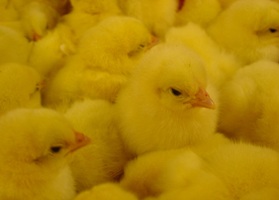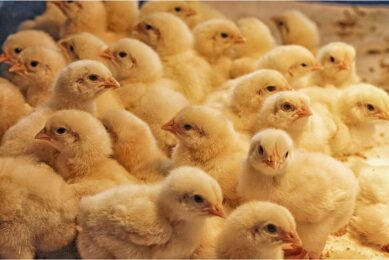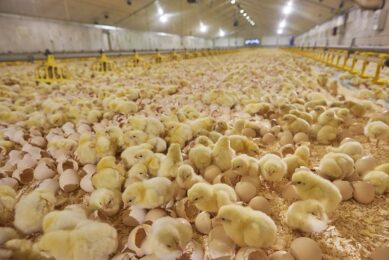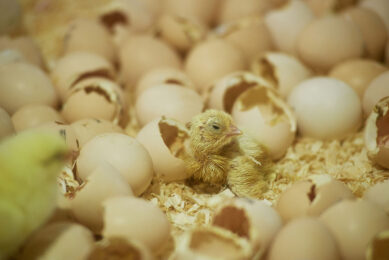Overheated chick calculations

When holding or transporting chicks, it is of utmost importance to control their body temperature within the optimal range of approximately 104-104.5ºF (40.0-40.3ºC). Although the ultimate check is to simply measure the body temperature of the chicks, it can be very informative to do some calculations on what happens with them, to see how the system operates and how sensitive it is.
By Dr. Ron Meijerhof , Poultry Performance Plus, Voorst, the Netherlands
To maintain their body temperature at a certain level, chicks have to find a balance between their heat production and the heat loss. A real accurate standard for heat production of a day-old chick is not available, but an estimated heat production of 0.3 watt for a day old chick that has not yet eaten seems to be a workable average. To warm up a body, a certain amount of energy is needed. For chickens this so called specific heat is 3.35 kJ per kg of chicken per degree Celsius. So to warm up 1 kg of day old chicks with 1ºC we need to add 3.35 kJ of energy. If we assume that a day old chick weighs on average 40 grams, it means warming up a chicken by 1ºC takes 0.134 kJ or 134 Joule.A day old chick produces 0.3 watt of heat, which is equal to 0.3 Joule of heat per second. If this heat is not completely removed the body will go up in temperature. If no heat is lost at all and the bird produces 0.3 Joule per second, with a specific heat of 134 Joule per chicken, it will take roughly 450 seconds (134 Joule / 0.3 Joule per second) or 7.5 minutes to increase their body temperature by 1ºC.
Increasing heat production
We do see that if the body temperature of the chick rises, it’s metabolism increases as well, resulting in more heat production. Exact figures on this are not known, but by looking at the incubation process (which is more intensively studied) we can assume that this heat production will increase with 10 to maximum 20% if body temperatures goes up. This means that the increase in body temperature by 1ºC will take even less than 7.5 minutes if no heat is removed. Of course, a situation where no heat is removed at all is just theory. But if the temperature of the air is equal to the temperature of the body, no heat will be lost directly to the air, and the chick has to find other ways to lose that surplus of heat.
We do see that if the body temperature of the chick rises, it’s metabolism increases as well, resulting in more heat production. Exact figures on this are not known, but by looking at the incubation process (which is more intensively studied) we can assume that this heat production will increase with 10 to maximum 20% if body temperatures goes up. This means that the increase in body temperature by 1ºC will take even less than 7.5 minutes if no heat is removed. Of course, a situation where no heat is removed at all is just theory. But if the temperature of the air is equal to the temperature of the body, no heat will be lost directly to the air, and the chick has to find other ways to lose that surplus of heat.
Breathing through nostrils
Luckily enough, nature has created an alternative way of heat loss. If water is evaporated, this has a cooling effect as it costs energy. When a chick is at optimum temperature, it breaths through its nostrils and by doing so, it evaporates about 1 to 2 gram of water in 24 hours. This means that it slowly loses water and would dehydrate but digestion of the residual yolk produces about 1 gram of metabolic water per 24 hour, so the bird is kept nicely in balance.
Luckily enough, nature has created an alternative way of heat loss. If water is evaporated, this has a cooling effect as it costs energy. When a chick is at optimum temperature, it breaths through its nostrils and by doing so, it evaporates about 1 to 2 gram of water in 24 hours. This means that it slowly loses water and would dehydrate but digestion of the residual yolk produces about 1 gram of metabolic water per 24 hour, so the bird is kept nicely in balance.
Evaporation of water costs energy, 2260 Joule per gram. This means that if a chicken evaporates 1 gram in 24 hour, it will lose 0.026 Joule per second (2260 J /24 h/3600 s). As its heat production is 0.3 Joule per second, this is not enough to lose all the generated heat, but when a chick breaths normally, its water loss by breathing contributes to about 10% of the total heat loss needed.However, if heat loss from the skin is not sufficient to lose the remaining 90% of the heat production, for instance because air temperature is too high, the body temperature will start to increase. The first reaction of the birds will be to spread out the wings and feathers a bit more, to increase surface area for heat loss, but if body temperature moves up to approximately 106ºF (41.1ºC), it will start panting as well. Panting is the birds substitute for sweating, and it cools the body by increasing the amount of moisture evaporated.
Just staying alive
In theory, a bird can loose all its heat by panting. If no heat would be lost through the skin (when air temperature is equal to body temperature) a bird would have to loose 0.3 watt (0.3 Joule per second) of heat by evaporation. If evaporation of 1 gram of moisture per 24 hour means a heat loss of 0.026 Joule per second, we can calculate that to be able to lose all of its heat by evaporation, the bird needs to evaporate approximately 11.5 grams of water per 24 hours. In reality it needs to evaporate even more water, as with it’s increased body temperature it will produce 10 to 20% more heat.
We know from experience that in heat stress situations, a bird can lose up to five and sometimes even 10 grams of water per 24 hours, so it means it can almost achieve the total heat loss needed by evaporation. Of course it will mean that in extreme situations a bird loses 20-25% of its body weight in 24 hours, which means that in this situation it cannot do much more than just trying to stay alive.
Increase relative humidity
To avoid this enormous dehydration, we can increase the relative humidity. This makes it more difficult for the bird to evaporate moisture, and the dehydration will be slowed down. Of course it also means that we prevent the birds survival mechanism for getting rid of the heat stress. The trick to prevent dehydration is to avoid overheating, so the birds do not need to use their survival mechanism. As the birds use their panting for a reason, stopping the symptom (panting) is not the same as curing the problem (overheating).
To avoid this enormous dehydration, we can increase the relative humidity. This makes it more difficult for the bird to evaporate moisture, and the dehydration will be slowed down. Of course it also means that we prevent the birds survival mechanism for getting rid of the heat stress. The trick to prevent dehydration is to avoid overheating, so the birds do not need to use their survival mechanism. As the birds use their panting for a reason, stopping the symptom (panting) is not the same as curing the problem (overheating).
An ideal situation for a bird is that a minimum amount of heat is lost by evaporation of water through the nostrils, as this means a minimum of dehydration. The remaining heat should be lost from the skin and the legs. To allow heat loss through the skin, a temperature difference between air and skin must be created, otherwise heat will not start to flow. If a certain temperature difference is present, the air velocity will determine how quickly the heat will be transferred between skin and air. Therefore, the combination from air velocity and air temperature dictates heat loss from the skin. If there is no temperature difference between air and skin, air velocity has no effect.
Checking body temperature
The correct combination of air temperature and air velocity will result in a perfect match between heat production by the bird and heat loss by the skin. As an imperfect match will very quickly lead to a shift away from the optimum body temperature, resulting in either panting chicks or under cooled chicks, checking the body temperature and aiming for 104-104.5ºF (40.0-40.3ºC) should be the ultimate proof of the pudding, to evaluate transport and holding conditions. If this aim is realised, a minimum in dehydration, chick mortality and chick quality loss can be expected.
The correct combination of air temperature and air velocity will result in a perfect match between heat production by the bird and heat loss by the skin. As an imperfect match will very quickly lead to a shift away from the optimum body temperature, resulting in either panting chicks or under cooled chicks, checking the body temperature and aiming for 104-104.5ºF (40.0-40.3ºC) should be the ultimate proof of the pudding, to evaluate transport and holding conditions. If this aim is realised, a minimum in dehydration, chick mortality and chick quality loss can be expected.
MORE INFORMATION |
Join 31,000+ subscribers
Subscribe to our newsletter to stay updated about all the need-to-know content in the poultry sector, three times a week. Beheer
Beheer











 WP Admin
WP Admin  Bewerk bericht
Bewerk bericht